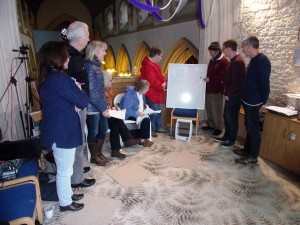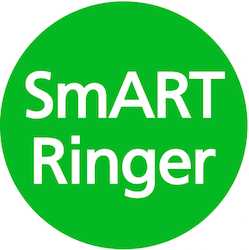A personal perspective by a Conducting Course (Part 1) training participant.
Most people reading will be more progressed than I in bell ringing. You may find this write-up a bit obvious but you may still enjoy, and remember, when you were where I’m at now. I learned Bob Doubles some years ago and then just when the plain course was becoming understandable somebody shouted BOB!
Two things happened. 1st (as my name is Bob) I assumed I’d gone wrong! Had I missed out that pesky long 5ths (again)? The 2nd thing was somebody said “don’t worry you are unaffected”. Since then I have rung various touches but never understood any of the ins & outs of calling (pun intended). So when the opportunity to attend the ART training at the Stretham Ringing Education Centre (REC) presented itself, I signed up!
I did struggle with the number crunching at the very start of the session. I’m quite numerate (although not a mathematician). So why did I struggle? I think it’s for two reasons: First, I found I really didn’t fully (or readily) understand the terminology. “Extents” & “Lead ends” etc. I’m not sure that’s a personal failing on my part but how often are these correct terms used in towers for plain bob learners? Second: Perhaps the paperwork sent out ahead of the day could mention “Make sure you are familiar with the following terms that will be used” – then I’d have been better prepared.
So with the number crunching done (that sounds bad but it wasn’t too hard really) it was into the practical work. First: “Call a touch by calling yourself unaffected first”. There was discussion about when to actually ‘know’ that it was time to call BOB and it was recognised that seeing where the treble was may be a distinct advantage. I struggle seeing where the treble is so I was happy knowing to call it on the first pull at long 5th (at back stroke).
Although probably simple to those more experienced ringers I was nearly tripped up on two effects:
When I’m at long 5ths I count the pulls (that sounds simple enough 1, 2, 3 & 4). I noticed that it seemed difficult for me to call BOB and count to ONE at the same time. This nearly translated into “BOB, 1, 2, 3 & 4” – which would be 5 pulls at in 5th place – Rookie mistake?
Multi-tasking. I have often jokingly said “I can’t ring and think at the same time”. During the exercise I had to ring (thinking through the circle of work) as well as start to add extra thinking in terms of “nearly there, nearly there, nearly there… call BOB”…
Second: “Call a touch by calling another bell unaffected”. Now… I understood the concept but I took a little too long grasping “How is that done?” There was discussion on partner bells, the circle of work as well as the “Isle Of Man”. It looked like the other course participants got it but not me. Apparently not only can’t I ring and think at the same time – I also struggle to think about ringing. The tutor was patient though and (eventually) after me pointing sequentially at my fingers (almost as a 5 year old would) saying “I’ll be doing this while the bell I want unaffected will be doing that” when penny finally dropped. What this meant was that the multitasking got a little more convoluted:
1) What is the next work for me?
2) Is that work at the same time as the work where the target bell is unaffected (yes or no)?
3) “Nearly there, nearly there, nearly there… call BOB”…
4) Now if that was IN when is OUT then when is MAKE… “Nearly there, nearly there etc…
Third: Ten of the above touches makes a quarter peal (nearly).. but in fact it’s 60 short of the 1260 needed.
We talked a bit on how you know you have rung ten touches by rotating through the bells sequentially calling each unaffected (to be honest it will be a while before I get, or want, that opportunity). We then had a chance of calling a 60 by using BPBPBP or PBPBPB. Again I demonstrated my inability to grasp this until I picked up the marker pen and wrote it on the whiteboard using my own phraseology:
This phraseology was (don’t laugh); Opportunity to call BOB… Miss opportunity to call P… Opportunity to call BOB… Miss opportunity to call P etc.
We did overrun by 45 minutes due, I’m sure, to my bloody minded approach to “I must get this” and the tutor’s intent to get me to understand. The tutor (Nicholas Small) was patient and knowledgeable even though I probably tested his resolve to stay calm. Barbara Le Gallez plied us with coffee and cream scones as well as aptly interpreted my quizzical looks into additional instructions for me. We rung using the simulator which worked so well that I quickly forgot it was a simulator. In all honesty I probably was not quite ready to be on the course but I managed!
I’d encourage people to attend this training if it runs again and of course it’s suitably timed for your development.

Conducting Course at Stretham

